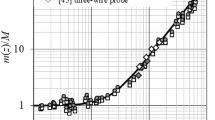Abstract
Experimental simulations were carried out to investigate the onset of instability in negatively buoyant fountains by injecting glycerin–water mixtures into silicon oil. The transition from a stable to an unstable fountain structure is primarily governed by the Richardson number, and to a lesser extent, Reynolds number, viscosity ratio, Weber number and vent geometry. Transition nominally occurs at a Ri = 1.0. For a fountain issuing from a cylindrical pipe, the major effect of the Reynolds number is in determining whether or not the fountain is laminar or turbulent. The Reynolds number effect can be largely accounted for by basing a corrected Richardson number on the root mean square of the mean velocity. Viscosity ratio deviating from unity has the effect of stabilizing the flow structure and thereby reducing the transition Richardson number. Similarly, interfacial tension stabilizes the flow pattern resulting in a trend of increasing transition Richardson number with increasing Weber number. The results are valid in rectangular vents if the Richardson number and Reynolds number are based on the hydraulic diameter.






Similar content being viewed by others
Abbreviations
- φ:
-
Vent shape parameter (accounts for circularity and taper angle)
- d :
-
Characteristic size of the mingling void
- ρF, ρS:
-
Densities of the fountain and surrounding fluids
- μF, μS:
-
Viscosities of the fountain and surrounding fluids
- σ:
-
Interfacial tension between fountain and surrounding fluids
- \( \ifmmode\expandafter\bar\else\expandafter\=\fi{U} \) :
-
Average velocity of fountain at the vent exit based on volumetric flow rate \( {\left( {\ifmmode\expandafter\bar\else\expandafter\=\fi{U} = {\ifmmode\expandafter\dot\else\expandafter\.\fi{V}} \mathord{\left/ {\vphantom {{\ifmmode\expandafter\dot\else\expandafter\.\fi{V}} A}} \right. \kern-\nulldelimiterspace} A} \right)} \)
- f :
-
Characteristic instability frequency of the fountain
References
Baines WD (1975) Entrainment by a plume or jet at a density interface. J Fluid Mech 68:309–320
Campbell IH, Turner JS (1985) Turbulent mixing between fluids with different viscosities. Nature 313:39–42
Cresswell RW, Szczepura RT (1993) Experimental investigation into a turbulent jet with negative buoyancy. Phys Fluids A 5:2865–2878
Friedman PD (2006) Oscillation in height of a negatively buoyant jet. ASME J Fluids Eng 128:880–882
Friedman PD, Katz J (1999) The flow and mixing mechanisms caused by the impingement of an immiscible interface with a vertical jet. Phys Fluids 11:2598–2606
Friedman PD, Katz J (2000) Rise height for negatively buoyant fountains and depth penetration for negatively buoyant jets impinging on an interface. ASME J Fluids Eng 122:779–782
Friedman PD, Winthrop AL, Katz J (2001) Droplet formation and size distributions from an immiscible interface impinged with a vertical negatively buoyant jet. At Sprays 11:269–290
Friedman PD, Meyer WJ, Carey S (2006) Experimental simulation of phase mingling in a subaqueous lava fountain. J Geophys Res 111
Incropera FP, DeWitt DP (2002) Introduction to heat transfer, 4th edn. Wiley, New York, pp 439–440
Kokelaar P (1986) Magma–water interactions in subaqueous and emergent basaltic volcanism. Bull Volcanol 48:275–289
Larson M, Jonsson L (1994) Mixing in a two-layer stably stratified fluid by a turbulent jet. J Hydraul Res 32:271–289
List EJ (1982) Turbulent jets and plumes. Annu Rev Fluid Mech 14:189–212
Longmire EK, Norman TL, Gefroh DL (2001) Dynamics of pinch-off in liquid–liquid jets with surface tension. Int J Multiph Flow 27:1735–1752
Munson BR, Young DF, Okiishi TH (2002) Fundamentals of fluid mechanics. Wiley, New York, pp 266–270
Qian F, Mutharasan R, Farouk B (1996) Studies of interface deformations in single- and multi-layered liquid baths due to an impinging gas jet. Metall Mater Trans B 27:911–920
Raffel M, Willert CE, Kompenhans J (1998) Particle image velocimetry. Springer, Berlin
Stone HA, Leal LG (1989) Relaxation and breakup of an initially extended drop in an otherwise quiescent fluid. J Fluid Mech 198:399–427
Turner JS (1966) Jets and plumes with negative or reversing buoyancy. J Fluid Mech 26:779–792
Wohletz KH (2002) Water/magma interaction: some theory and experiments on peperite formation. J Volcanol Geotherm Res 114:19–35
Wu X, Katz J (1999) On the flow structures and mixing phenomenon in a fuel/water stratified shear flow. Proceedings of the third ASME/JSME joint fluids engineering conference, 18–23 July, 1999, San Francisco
Zimanowski B, Fröhlich G, Lorenz V (1995) Experiments on steam explosions by interaction of water with silicate melts. Nucl Eng Des 155:335–343
Acknowledgments
This material is based on work supported by the National Science Foundation under Grant No. 0408946.
Author information
Authors and Affiliations
Corresponding author
Rights and permissions
About this article
Cite this article
Friedman, P.D., Vadakoot, V.D., Meyer, W.J. et al. Instability threshold of a negatively buoyant fountain. Exp Fluids 42, 751–759 (2007). https://doi.org/10.1007/s00348-007-0283-5
Received:
Revised:
Accepted:
Published:
Issue Date:
DOI: https://doi.org/10.1007/s00348-007-0283-5




